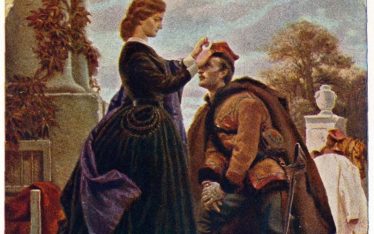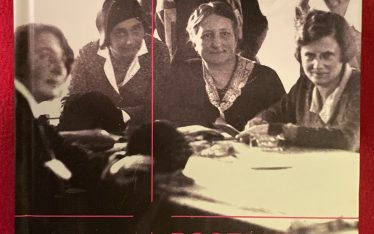As the UK has celebrated the accession of King Charles III to the throne, I’m looking back at Polish coronations and to the main crown used, as above. I’m particularly fascinated by the lavish coronation of a Polish King who was not a hereditary king, Grand Hetman Jan Sobieski.
Anointing makes a King
Of course a ruler isn’t a King unless they have been anointed by the highest church authority. Mieszko the First, known as the first ruler of Poland, brought Christianity to the country in 966, having first united the Polish lands. His eldest son Bolesław Chrobry (Bolesław the Brave) who ruled from 992, was the first crowned king, but his coronation didn’t happen until 1025, the same year he died. At the time, permission had to be sought from the Holy Roman Emperor and the Pope. For many years both incumbents were against the idea of Poland becoming a kingdom. When they died, the road was open for Bolesław to become the first King of Poland, anointed by archbishop Hipolit in the new Cathedral in Gniezno, the first seat of Polish Kings.

The coronation of Bolesław Chrobry by Jan Matejko. Photo: public domain
Glittering Crowns
As for Bolesław’s crown, one story recounts that it was waiting for him for so long that it was sent instead to the Hungarian King and another, that he received one from The Holy Roman Emperor Otto II in 1000, but no such crown was passed on to Bolesław’s descendants.
A crown wasn’t actually made until 1320 for Władysław Łokietek but was called the Chrobry Crown for continuity. Almost all Polish Kings were crowned with the Chrobry Crown. Sadly it was seized by the Prussians in 1794 and the gold melted down into coins! The replica shown above, was created between 2001 and 2003.
Only Stefan Batory (1576-1586) and August III (1733-1763), both elected Kings were the exceptions who didn’t wear the crown. The Chrobry crown was hidden from August III by supporters of the previous King who had been removed from power so a new crown was made.
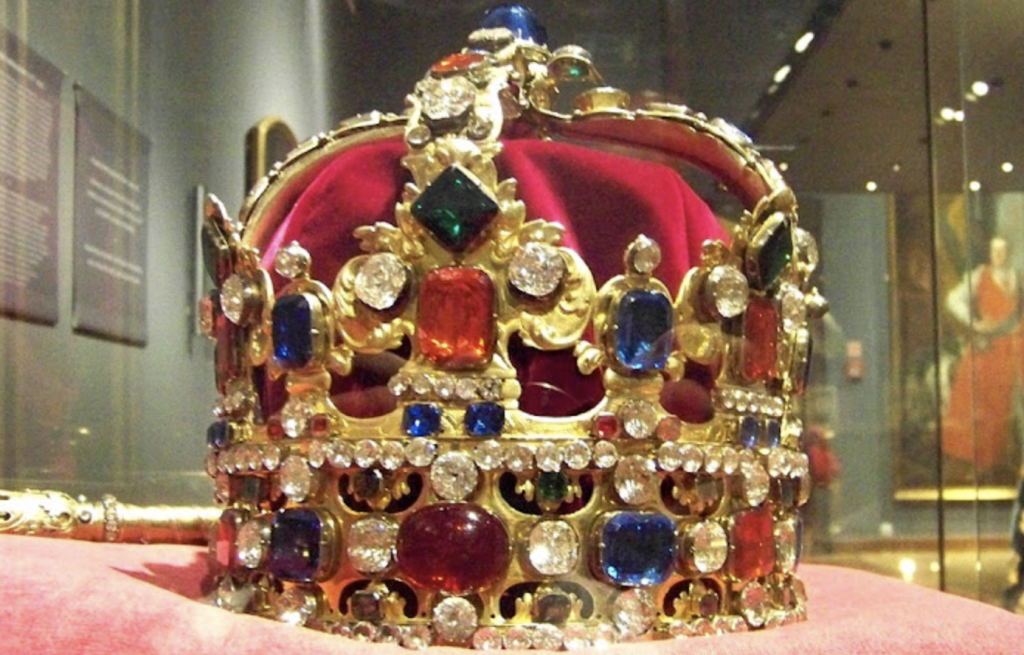
Crown of August III in Warsaw National Museum
It is this August III crown that is the only set of Polish regalia that has survived, although it too was stolen by a German ruler who sold it to a collector. It was finally bought back by the Polish National Museum in 1924 when Poland had become a Republic. Stolen again by the Germans in World War II, it was found by the Soviet army, taken to the Soviet Union and returned to Poland in 1960.
Elected Kings
After the last of the Jagiellonian kings died in 1572 without an heir, the Polish nobles decided they would elect their kings rather than rely on the heirs inheriting the throne. This form of democracy did not necessarily bring better rulers for the next hundred years but in 1674, Jan III Sobieski, the eighth King in a hundred years was one of the most extraordinary and visionary monarchs. A fearless commander-in-chief of the army, with many victories behind him, he defeated the Turks with a decisive attack at Chocim (Khotyn in present day Ukraine) over the Dniester river, just as the King died and elections for a new King were to take place. He wasn’t even a candidate until the French and Austrian candidates lost backing but he was elected with overwhelming support.
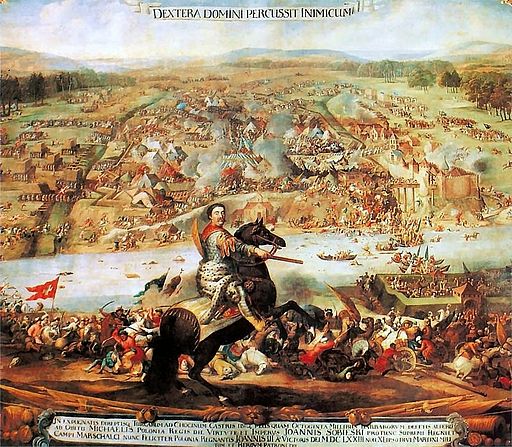
Battle of Chocim (Khotyn) by Andreas Stech, Photo: Public domain
A lifelong love
Jan Sobieski had a not dissimilar love story to Charles III. When he was young he met and fell in love with 14 year old Marie-Casimire d’Arquien. Although French, Marie’s god-mother was the wife of first Kings Władysław III and then of King Jan Kazimierz. She had brought Marie to the Polish court where she became much loved and called Marysienka. Her god-mother had ambitions for her and although Marie was also besotted with Jan, she was married to Jan Zamojski, a powerful magnate and successful commander.
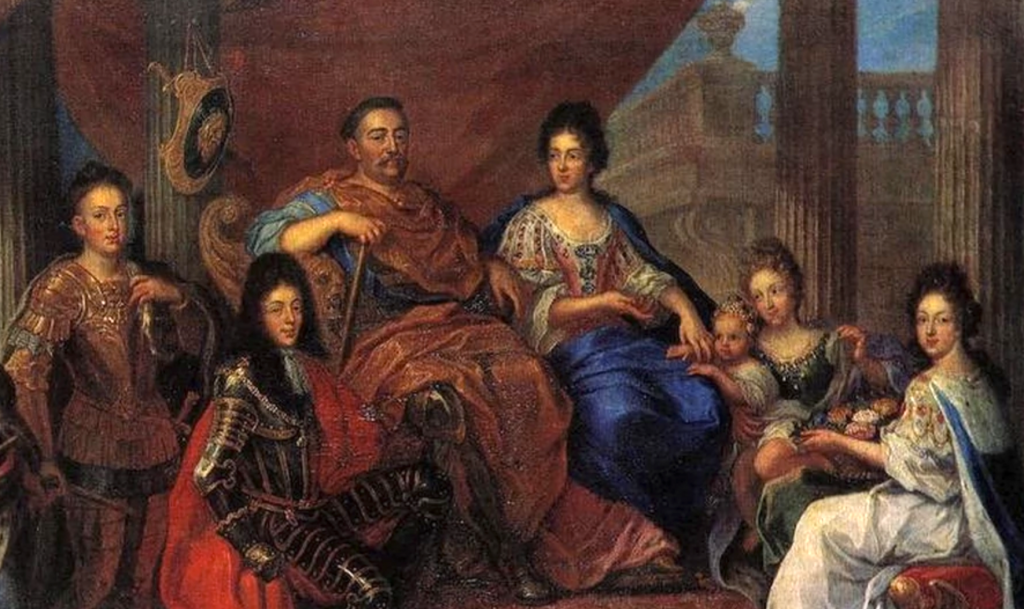
Jan Sobieski and Marysienka by Henri Gasgard (1635 – 1701) Public domain.
The marriage predictably wasn’t made in heaven. When every child she gave birth to died, her husband spent months away and Jan Sobieski came back on the scene. They exchanged passionate love letters and only a week after her husband’s death were secretly married in April 1665 followed by an official wedding three months later which didn’t go down well as the tradition was to observe a year of mourning. The letters continued throughout their lives whenever they were parted and were ardent to the end.
Coronation procession
The lavish coronation of King Jan III and Marysienka took place on 2 February 1676 in Wawel Cathedral. Welcome gates were prepared to praise Sobieski’s numerous victories for their entry to Krakow on 30 January. The coronation vehicle, an open carriage was upholstered with crimson velour, trimmed with gold and padded with white satin. An eyewitness says the monarch was dressed in “a blue sable-lined overcoat interwoven with gold and silver, crimson lined żupan interwoven with gold, diamond buttons and a clasp of large diamonds as well as a huge ruby unseen elsewhere in Europe. He rode “a gorgeous grey horse in a blue cloth of gold” with diamond trappings and was crowned with the Chrobry Crown. Although there are no paintings of the coronation this painting by Józef Brandt gives an idea of the ceremony with with they travelled.
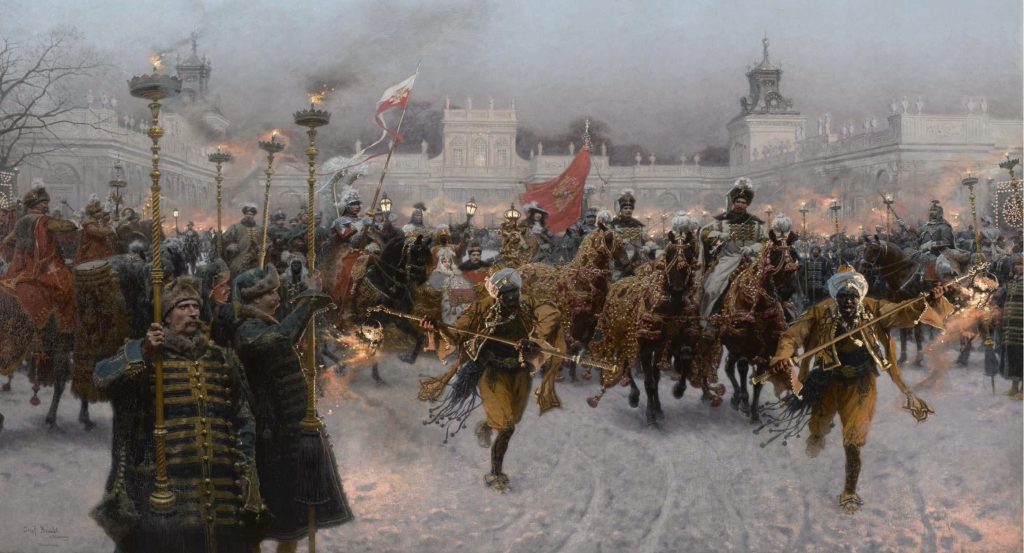
Józef Brandt, Wyjazd Jana III i Marysieńki z Wilanowa, (Departure of Jan III and Marysieńka from Wilanów) 1897. Photo: National Museum of Warsaw
Supported by his wife, he went onto win many more battles culminating in the Siege of Vienna. In 1683 he signed a treaty with The Holy Roman Emperor Leopold I against the Turks and when the same year the Turkish army approached Vienna, Sobieski was honour bound to support Leopold with an army of 25,000 men. The night before the battle, ever devoted, he wrote to his wife: ‘the only solace of my heart and soul, the loveliest and most beloved Marysieńka’.
As the highest ranking leader there, he took command of all 75,000 troops and achieved a massive victory which is seen as a key battle in European history, proving himself to have been an excellent choice for King of Poland.
This article was written on the basis of many sources including Wilanów Palace, Museum of Polish History, Nasza Historia and Polskie Dzieje.


 1.Tracing Family History pre-WW2
1.Tracing Family History pre-WW2 2. Tracing Family History WW2
2. Tracing Family History WW2
